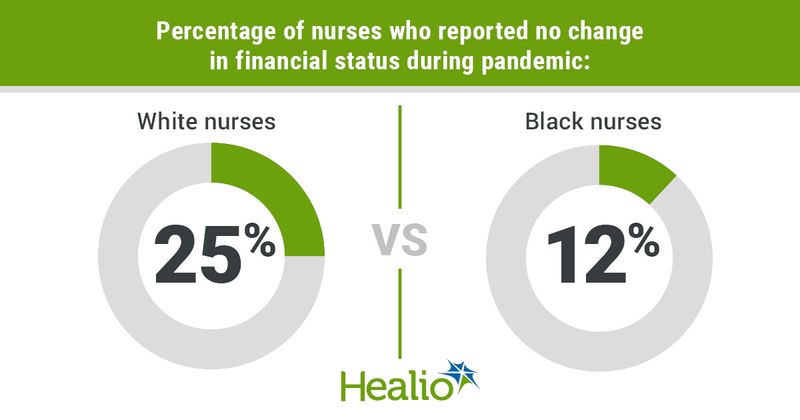Equity, equality and the disproportionate financial impact of COVID-19 on Black nurses
A recent survey of 10,000 nurses explored the impact of the COVID-19 pandemic on personal finances. While many of the findings reflect financial concerns faced by many Americans during these uncertain times, one thing is clear: Black nurses are disproportionately impacted.
In the survey conducted by the American Nurses Foundation, the philanthropic arm of the American Nurses Association, results underscore wide gaps in financial wellness among white and Black nurses. Although there were no significant differences in employment status during COVID-19 (roughly one-third of nurses reported that their work schedules remained the same as before the pandemic), the material impact of the pandemic on finances was significant. Nearly 38% of Black nurses had to stop making student loan payments compared with just 22% of white nurses. Nine percent of Black nurses relied on some form of public assistance compared with just 2% of white nurses. And a third of Black nurses reduced utilities and halted services compared with just 23% of white nurses. Indeed, a quarter of all white nurses reported no change in their financial status; only 12% of Black nurses could say the same.

While much has been discussed about compensation disparities in health care along the lines of gender, data on pay gaps among racial and ethnic minorities are limited. One report from Massachusetts General Hospital revealed that half of Black women working in the industry earned less than $15 per hour. A 2016 U.S. Census Bureau survey found that women were paid 80 cents for every dollar paid to their male counterparts; Black women were paid just 63 cents to the dollar.
But there’s a deeper narrative within these data. Even when controlling for actual pay, Black nurses bear greater financial hardship than their white colleagues. This presents an important opportunity for employers to explore the specific and nuanced challenges of their workforce in order to better understand, care for and retain employees.
Equality efforts fall short
In recent years, more egalitarian HR processes have been implemented in the ranks of junior and mid-level positions (sadly, opacity in senior leadership prevails). From blind hiring to standardized procedures for recruitment, promotion and retention, strides have been made to institute practices designed to ensure an equal playing field — like classification systems for compensation, reductions in staffing that reward seniority, and employee assistance and bonus initiatives based on years served in an organization. At first glance, these practices appear to foster greater transparency and fairness.
And yet, when a population has been historically marginalized, practices that hold equality as their cardinal aim may have the effect of reinforcing inequity by failing to recognize that employees of color are likely entering the workforce — and in today’s context, a pandemic — from a position of vulnerability.
Thus, “last one in, first one out” rules disproportionately impact women and minorities who may have only recently been accepted into the roles they now occupy. Employee assistance programs like student loan contributions tied to longevity in an organization dismiss people of color at higher rates. Meanwhile, employees who qualify for and take advantage of these perks widen the advancement and pay gaps between themselves and their Black colleagues, unintentionally maintaining disparities in the name of equality.
‘Do better’
As more efforts emerge nationwide to address inequities both exposed and exacerbated during this pandemic, it behooves health care leaders to look past broad headlines to understand how gender, race and history intersect to create unique conditions that don’t always lend to a uniform solution. We must therefore probe the data to glean greater nuance about the ways our policies and practices affect those on the frontlines and the margins.
As Maya Angelou noted, “Do the best you can until you know better. Then when you know better, do better.” With the latest data from the American Nurses Foundation, we have more evidence of the painful strains on nurses of color. Now let’s do better.
References:
American Nurses Association. New Pulse on the Nation’s Nurses Survey Series: COVID-19 Pandemic Financial Impact Greater for Black and Hispanic/Latino Nurses. https://www.nursingworld.org/news/news-releases/2020/new-pulse-on-the-nations-nurses-survey-series-covid-19-pandemic-financial-impact-greater-for-black--and-hispaniclatino-nurses/. Accessed Oct. 21, 2020.
American Nurses Association. Pulse on the Nation’s Nurses COVID-19 Survey Series: Financial. https://www.nursingworld.org/practice-policy/work-environment/health-safety/disaster-preparedness/coronavirus/what-you-need-to-know/financial-impact-survey/. Accessed Oct. 21, 2020.
Himmelstein KEW, Venkataramani AS. Am J Public Health. 2019;doi:10.2105/AJPH.2018.304801.

